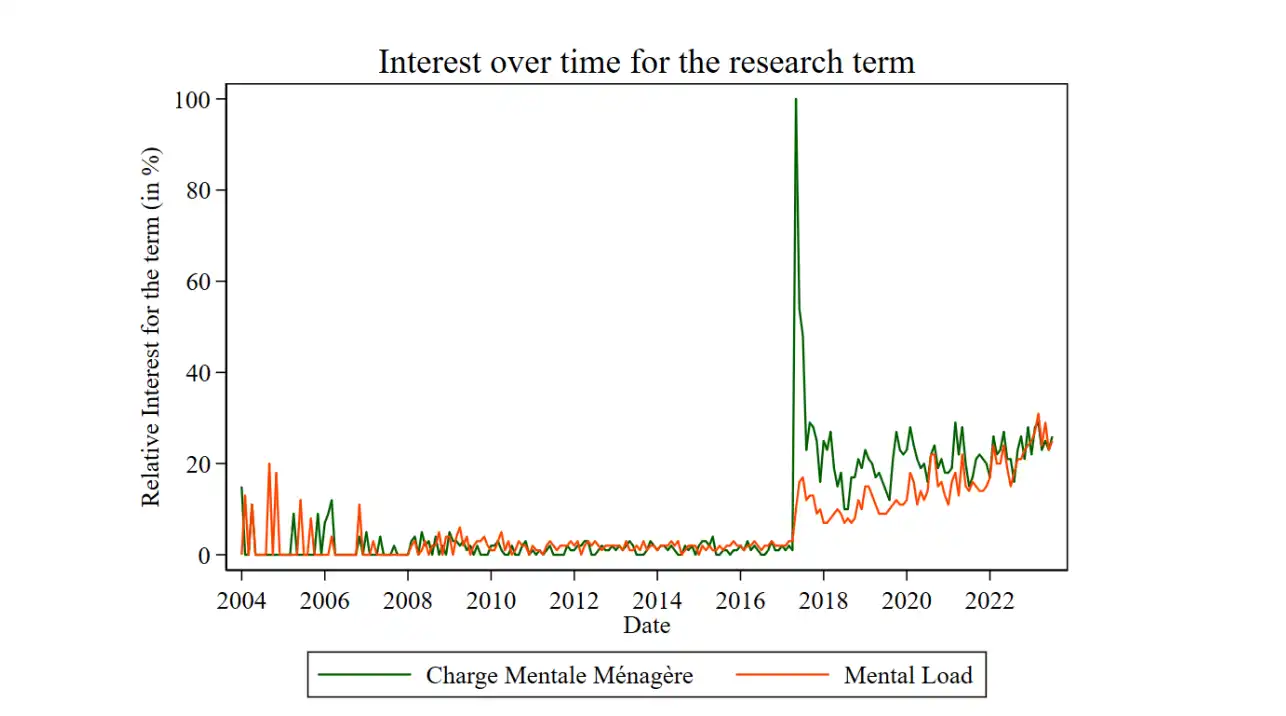Home>“You Should Have Asked”: The Mental Load in Relationships

24.04.2024
“You Should Have Asked”: The Mental Load in Relationships
Article by Leïla Costil, Research assistant
“Mental load” is a concept that has entered the public debate recently. As illustrated by its Google trend, this concept (or its French equivalent, “la charge mentale”) have seen a rapid peak in searches after 2017 and remains present in generalist media*. However, this concept has been studied in academia since the 1980s, under different names, and with slightly different meanings depending on the researchers and the fields of study. How is the mental load studied in the academic field? And how can economists tackle this question?
The mental load: various definitions
Economists have long been working on unpaid, household work. Their findings have helped highlight gender inequalities in the organisation of the home and their consequences on the labour market. This topic remains greatly relevant: unpaid work, such as caring for children, the elderly, or household chores, represent an important share of economic activity, but remains unaccounted for in GDP computations. Moreover, inequalities persist as women still carry most of the unpaid work in households and do on average two more hours of unpaid work per day than men (IMF Working Paper, 2019). However, economists have failed to take into account the mental load, which remains mostly a sociological topic as of today. In the early works, the subject of the mental load in sociology is mostly considered in its practical part as the “management of domestic life”, and carries many names: “mental labour”, “emotion work”, “thought work”, “invisible work” (Hochschild, 1983; Hochschild, 1989; DeVault, 1991; Walzer, 1996).
The mental load is defined as a discrete category of family work, which entails the planning, scheduling, and remembering of domestic chores and events. If couples often experience an unequal distribution of the mental load before the arrival of the first child, this event often increases the mental load: when couples have their first child, parents often adopt different roles, and men and women often recreate mother and fatherhood as differentiated social experiences. Such differentiated experience entails that mothers and fathers do not experience the same amount of mental workload, which is found to be a source of tension (Walzer, 1996). Over the past thirty years, more researchers have studied this concept: instead of being considered as only a part of domestic work, the mental load gained consideration as a distinct cognitive dimension of household life (Daminger, 2019). It entails anticipating needs, identifying options for fulfilling them, making decisions, and monitoring progress – all activities that are not only requiring time, but also attention, mental space, and long-lasting focus. Moreover, studies increasingly shed light on the emotional aspect of mental labour, which includes the feelings of caring and being responsible for family members, as well as carrying the emotional impact of this work. The mental load is enduring because it is linked to the care and emotion of loved ones - which is never ending (Dean, Liz, Churchill and Ruppanner, 2022).
The role of economics in the study of the mental load
Economists face limitations on this topic, and very few researchers have studied the concept from an economic perspective. Such studies could however provide important knowledge: one could see the interest in estimating the impact of the mental load on productivity in paid activities and women’s opportunity costs of experiencing it, so as to understand the possible gains of implementing public policies tackling the mental load problem. In fact, most work on the mental load is still coming from the sociological field, with many researchers working in the past decades to define this phenomenon and estimate its importance and impact. Sociologists often use quantitative data to that goal, and focus on time-diary studies where couples are invited to declare the time spent on different chores and activities. As such, some aspects of the mental load can be highlighted: time-use data support the idea that one hour of a woman’s housework time is not exactly equivalent to a man’s because women’s leisure time is more frequently interrupted than men’s (Sullivan, 1997). In addition, women spend more hours per week multitasking (Offer and Schneider, 2011). However, the mental load is defined by its permanence - it is the constant exercise of not forgetting important events and information and the active work of caring for others throughout the day - and does not necessarily translate into physical activities (Daminger, 2019). As such, time-use approaches face limitations which have led some studies to find an insignificant gender gap in mental work (Lee and Waite, 2005; Offer and Schneider, 2011). Finding other ways of quantifying the impact of the mental load remains a challenge for both the sociological and economics fields.
To go further: new approaches
Other academic fields contribute as well to further understanding the mental load. Studies in psychiatry and preventive medicine focusing on sleep have found that women sleep on average less than men in the same household, and that women’s sleep is more disturbed by issues related to children in the home and partners’ employment, while men’s sleep is more disturbed by their own employment and household finances (Maume, Hewitt and Ruppanner, 2018). Moreover, such troubled sleep is most likely the result of chronic stress (Hall et al., 2015). This is related to the mental load: women are sleeping less and worrying more about other members of the household. Moreover, the use of qualitative techniques in sociology contribute to our understanding of the mental load. Women are found to do more cognitive labour overall and more of the anticipation and monitoring work in the household – overall, the mental work in a household is done mostly by women, except for decision-making, which is approximately equally shared between men and women (Daminger, 2019; Offer, 2014; Sayer, 2005; Hochschild, 1989).
Solutions to the mental load
Overall, broad research that relies on new quantitative data focusing on the mental load is still necessary at the academic level. Questions related to cognitive work need to be implemented in national and international-wide studies, so as to allow for quantitative work to fully tackle this topic.
*The particular French peak can be explained by the publication of the graphic novel “Fallait demander!” by Emma on May 9th, 2017.
Bibliography
Craig, L., & Brown, J. E. (2016). “Feeling rushed: Gendered time quality, work hours, nonstandard work schedules, and spousal crossover.” Journal of Marriage and Family, 79(1), 225–242. https://doi.org/10.1111/jomf.12320
Daminger, A. (2019). “The cognitive dimension of household labour”. American Sociological Review, 84 (4), 609–633. https://doi.org/10.1177/0003122419859007
Dean, Liz, Brendan Churchill, and Leah Ruppanner. “The Mental Load: Building a Deeper Theoretical Understanding of How Cognitive and Emotional Labor Overload Women and Mothers.” Community, work & family 25, no. 1 (2022): 13–29.
DeVault, Marjorie. (1991). Feeding the Family: The Social Organization of Caring as Gendered Work. Chicago: University of Chicago Press.
Hall, M. H., Casement, M. D., Troxel, W. M., Matthews, K. A., Bromberger, J. T., Kravitz, H. M., & Buysse, D. J. (2015). “Chronic stress is prospectively associated with sleep in midlife women: The SWAN sleep study.” Sleep, 38(10), 1645–1654. https://doi.org/10.5665/sleep.5066
Hochschild, A. R. (1989). The second shift: Working parents and the revolution at home. Viking
Hochschild, Arlie Russell. (1983) The Managed Heart: Commercialization of Human Feeling. 1st ed. Berkeley: University of California Press.
IMF working paper, 2019. Reducing and redistributing Unpaid Work: Stronger Policies to Support Gender Equality
Lareau, Annette, and Elliot B. Weininger. “Time, Work, and Family Life: Reconceptualizing Gendered Time Patterns Through the Case of Children’s Organized Activities” Sociological forum (Randolph, N.J.) 23, no. 3 (2008): 419–454.
Maume, David J, Hewitt, Belinda, & Ruppanner, Leah. (2018). “Gender Equality and Restless Sleep Among Partnered Europeans”. Journal of Marriage and Family, 80(4), 1040–1058. https://doi.org/10.1111/jomf.2018.80.issue-4
Offer, S. (2014). “The cost of thinking about work and family: Mental labour, work-family spillover, and gender inequality among parents in dual-earner families”. Sociological Forum, 29(4), 916–936. https://doi.org/10.1111/socf.12126
Sayer, L. C. (2005). “Gender, time and inequality: Trends in women’s and men’s paid work, unpaid work and free time”. Social Forces, 84(1), 285–303. https://doi.org/10.1353/sof.2005.0126
Walzer, Susan. (1996) “Thinking About the Baby: Gender and Divisions of Infant Care.” Social problems (Berkeley, Calif.) 43(2), 219–234.
